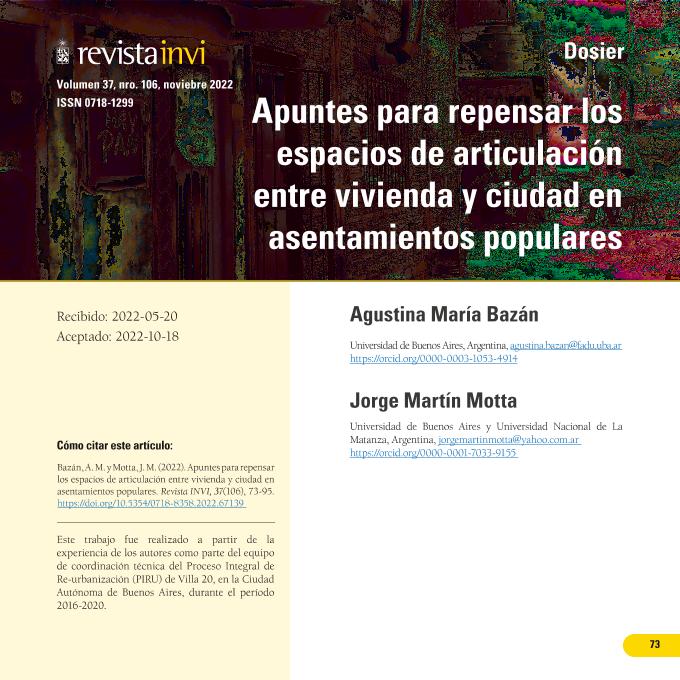Mostrar el registro sencillo del ítem
dc.contributor.author
Bazán, Agustina María

dc.contributor.author
Motta, Jorge Martin

dc.date.available
2023-06-23T14:57:12Z
dc.date.issued
2022-11
dc.identifier.citation
Bazán, Agustina María; Motta, Jorge Martin; Apuntes para repensar los espacios de articulación entre vivienda y ciudad en asentamientos populares; Universidad de Chile. Facultad de Arquitectura y Urbanismo; Revista INVI; 37; 106; 11-2022; 73-95
dc.identifier.issn
0718-8358
dc.identifier.uri
http://hdl.handle.net/11336/201295
dc.description.abstract
El espacio público de los asentamientos populares latinoamericanos es, fundamentalmente, un efecto de la producción social del hábitat y, en algunos casos, de la intervención de políticas públicas. En estos contextos, los espacios de articulación entre vivienda y ciudad resultan de especial interés por la variedad de usos y funciones que son capaces de albergar, haciendo difusos los límites entre la esfera pública y privada del hábitat. El presente artículo busca caracterizar, de manera exploratoria, los espacios de articulación entre vivienda y ciudad en asentamientos populares, tomando como caso de estudio la Villa 20 en Buenos Aires. Dicho barrio atraviesa, desde 2016, un Proceso Integral de Re-urbanización (PIRU) llevado adelante por el Estado local. A través de un enfoque cualitativo, basado en el análisis documental y la observación de campo, se señalan funciones, usos y significados de los espacios de articulación entre vivienda y ciudad. Entre los hallazgos, se corrobora que su organización posee características profundamente diferentes a las de otros espacios urbanos de la ciudad y se señalan algunos elementos a considerar a la hora de intervenirlos desde la política pública. Además, se recupera la potencia de “lo cotidiano” como perspectiva de estudio para el espacio urbano latinoamericano.
dc.description.abstract
The public space of Latin American popular settlements is fundamentally the result of the social production of the habitat and, in some cases, of the intervention of public policies. In these contexts, the spaces of articulation between housing and the city are of special interest due to the variety of uses and functions that they are capable of harbor. Frequently, they are conceived as an extension of the home, blurring the boundaries between the public and private spheres of habitat. The article seeks to characterize, in an exploratory manner, the spaces of articulation between housing and the city in popular settlements, taking Villa 20 in Buenos Aires as a case study. This neighborhood has been going through, since 2016, a Comprehensive Re-urbanization Process (PIRU) carried out by the local State. Through a qualitative approach, based on documentary analysis and field observation, functions, uses and meanings of the spaces of articulation between housing and city are pointed out. Among the findings, it is corroborated that its organization has different characteristics from other urban spaces in the city, some elements to consider when intervening them from public policy are pointed out. In addition, it recovers the power of “everyday life” as a study perspective for the Latin American urban space.
dc.format
application/pdf
dc.language.iso
spa
dc.publisher
Universidad de Chile. Facultad de Arquitectura y Urbanismo
dc.rights
info:eu-repo/semantics/openAccess
dc.rights.uri
https://creativecommons.org/licenses/by-nc-sa/2.5/ar/
dc.subject
ESPACIO PÚBLICO
dc.subject
ARTICULACIÓN
dc.subject
PRODUCCIÓN SOCIAL DEL HÁBITAT
dc.subject
RE-URBANIZACIÓN
dc.subject.classification
Estudios Urbanos

dc.subject.classification
Geografía Económica y Social

dc.subject.classification
CIENCIAS SOCIALES

dc.title
Apuntes para repensar los espacios de articulación entre vivienda y ciudad en asentamientos populares
dc.title
Notes to rethink articulation spaces between housing and city in popular settlements
dc.type
info:eu-repo/semantics/article
dc.type
info:ar-repo/semantics/artículo
dc.type
info:eu-repo/semantics/publishedVersion
dc.date.updated
2023-06-16T12:56:34Z
dc.journal.volume
37
dc.journal.number
106
dc.journal.pagination
73-95
dc.journal.pais
Chile

dc.description.fil
Fil: Bazán, Agustina María. Universidad de Buenos Aires. Facultad de Arquitectura y Urbanismo. Centro de Investigación Hábitat y Energía; Argentina. Consejo Nacional de Investigaciones Científicas y Técnicas; Argentina
dc.description.fil
Fil: Motta, Jorge Martin. Consejo Nacional de Investigaciones Científicas y Técnicas; Argentina. Universidad de Buenos Aires. Facultad de Arquitectura, Diseño y Urbanismo; Argentina
dc.journal.title
Revista INVI
dc.relation.alternativeid
info:eu-repo/semantics/altIdentifier/url/https://revistainvi.uchile.cl/index.php/INVI/article/view/67139
dc.relation.alternativeid
info:eu-repo/semantics/altIdentifier/doi/https://doi.org/10.5354/0718-8358.2022.67139
Archivos asociados
